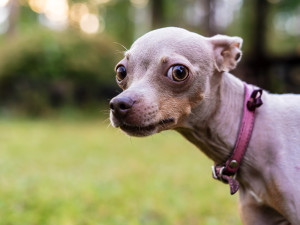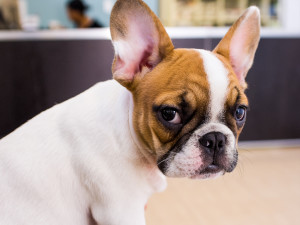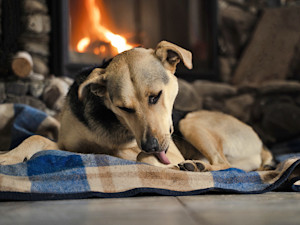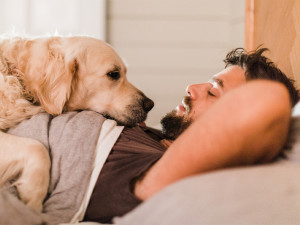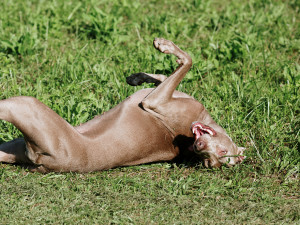Should You Clean Your Dog’s Ears at Home?
Heed all those cautionary tales about cotton buds
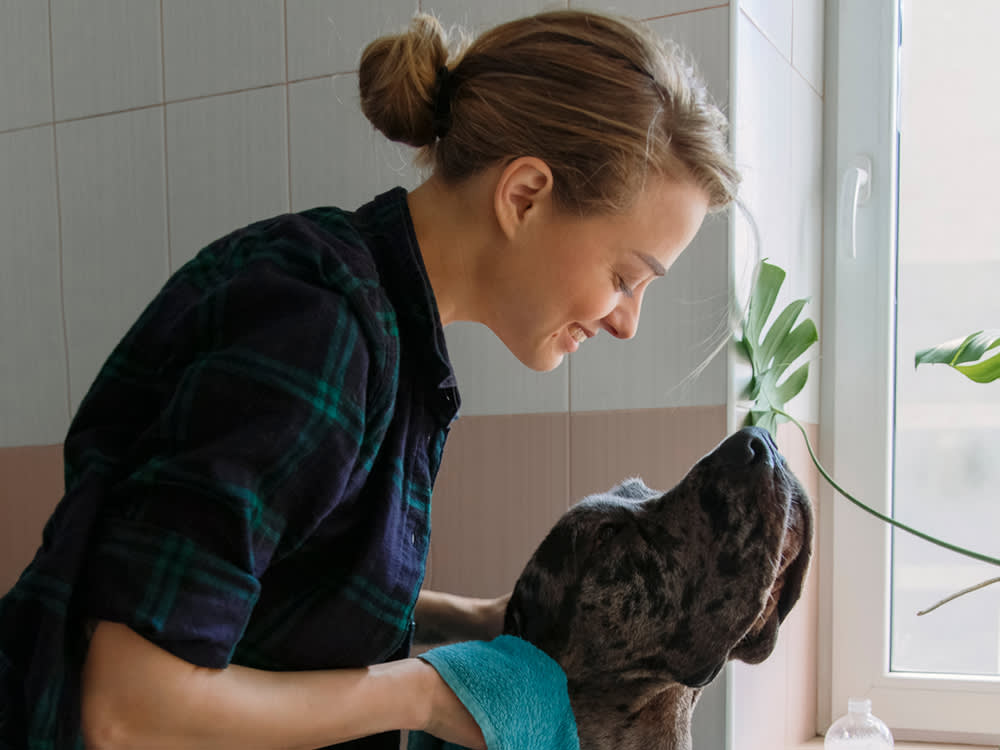
Share Article
Since the age you were able to start an independent morning bathroom routine, your mum has been warning you not to stick cotton buds in your ears. And if she didn’t, Lena Dunham’s cautionary taleopens in a new tab in season 2 of Girls should have tipped you off. Humans have found better, healthier ways to take care of our ears, and it’s time you start treating your dogs’ ears with the same careful, safe attention.
Some lucky pups have naturally healthy, self-cleaning ears that require little to no maintenance, but others might need a little help. If you notice that your dog has an excess build-up of dirt, wax or debris during your regular ear massages, you might wonder if your dog’s ears need to be cleaned. The answer: yes. Ear irritation and infections caused by this build-up are relatively common in dogs because of the shape of their ears, so providing your pup with regular at-home ear cleaning may help keep them healthy.

littleKin™ is Kinship’s home just for puppy and kitten parents. Bop over to check out expert advice, new pet tools, and special deals—all curated for your newest family member.
opens in a new tabWhile ear cleanings can contribute to your dog’s overall health, over-cleaning can cause more harm than good. It’s best to perform ear cleaning only as needed (unless directed otherwise by your vet), so familiarise yourself with the appearance of your dog’s healthy, clean ears and consult your veterinarian for anything that seems unusual.
Basic tools
You don’t need a lot of tools to clean your dog’s ears at home. This can be messy work, so find an easy-to-clean surface or put a blanket or towel under your dog.
Ear wash solution
Cotton balls
Cotton buds (if used with caution)
How to clean your dog’s ears
OK, how exactly do you clean your dog’s ears? Let’s be honest: most dogs dislike having their ears cleaned, so it is important to practice with your pup before attempting to do any actual cleaning. Some dogs may happily sit in your lap, but others could require restraint. (The instructions below assume the right ear is being cleaned.) For detailed photos and additional instructions, see this post from Washington State Universityopens in a new tab.
1. Get in position
With your dog lying down, you should stand on the opposite side of the ear you are cleaning.
2. Massage your dog
If your dog enjoys it, gently massage your dog’s neck and ears to get them relaxed.
3. Wrap your arms in a hug around your dog
Rest your right arm across your dog’s shoulder. Then, as if you are giving them a hug, wrap your left arm under and around their neck. If your dog tries to stand, lean your upper body over their shoulders to prevent them from getting up. If your dog is too wiggly, you could try laying them on their side.
4. Pull back the ear flap with your free hand
Use the left hand’s fingertips to push the ear flap back and up to expose the inner surface of the ear.
5. Squeeze the ear wash solution into the ear canal
Holding the bottle with your right hand, add a few drops of ear wash to the inside of the ear flap. Next, the tip of the cleanser bottle should be inserted a few millimetres into the ear canal, add some of the ear solution. Careful here not to force the tip of the bottle into the ear canal; that could rupture the eardrum.
6. Let your dog shake their head
As you can imagine, most dogs will shake their head once the cleaning solution is in their ear, shaking out much of the solution. That’s fine and expected.
7. Gently massage your dog’s ears
Your dog will probably like this part. Massage the base of the ear to distribute the wash solution throughout the ear canal.
8. Swab with cotton balls
Use cotton balls to remove discharge from the inner side of the ear flap.
9. Swab with cotton buds (optional)
You can use cotton buds to gently clean the inner side of the ear flap, but never stick cotton buds into the ear any further than you can easily see. Inserting a cotton bud too far can pack wax and other debris further into the ear canal or, worse, rupture the eardrum. This would lead to bigger problems or prevent medications from penetrating deeper parts of the ear canal. Remember: you wouldn’t do it to your own ear, so don’t do it to your dog’s.
Dog ear-cleaning solutions
Most veterinarians carry ear cleaning solutions, so consult yours for a safe vet-approved ear wash. If they don’t have them in stock, your veterinarian will be able to provide you with safe and healthy recommendations for your dog. Due to the possibility of ear infections, it’s best not to use a DIY ear-washing solution without consulting your vet first. Ears are incredibly sensitive and require mild solutions, so don’t consider using vinegar, hydrogen peroxide or alcohol on your dog’s ears, which could cause painful irritation.
If you need to apply prescription ear medication provided by your vet, you’ll find that ear medications are most effective when placed in a clean ear rather than applied on top of ear wax or other debris. Follow your veterinarian’s instructions on how to apply and whether your dog needs their ears cleaned before you apply medications to them.
Preventing ear infections
Routine cleaning of your dog’s ears can be a powerful tool in preventing ear infections for those dogs most susceptible to it. An interesting note is that dogs have many more ear problems than cats. Dogs with heavy, floppy ears tend to have the most issues with ear infections. Certain dog breeds with lots of hair in and around the ear canal may also be more prone to developing ear infections.
Besides genetic factors, lifestyle also plays a role. Dogs who spend lots of time in the water are prone to developing ear infections, among other conditions like limber tailopens in a new tab. Veterinarians also find that dogs with skin allergies may experience ear infections as part of the allergy.
Airflow is important to maintaining a healthy ear. Having lots of fur at the ear canal opening reduces airflow into the ear, so talk with your veterinarian if you think this might be an issue.
When you shouldn’t do at-home ear cleaning
Ask your veterinarian if at-home ear cleaning would be helpful for your dog. Your veterinarian may recommend a thorough ear exam under sedation if they find problems with your dog’s ears beyond mild build-up. There are several reasons why a vet may make this recommendation:
A dog that will not allow thorough cleaning of heavy build-up while awake.
Suspected foreign body such as plant material inside the ear canal.
The veterinarian needs to collect samples from the ear for cytology or culture.
Ear infection is suspected.
Signs of possible ear infection in dogs include redness, scabs, rash, crust, moisture or other discharge in the ear canal, along with any strong odour. If your dog typically enjoys having their ears rubbed and suddenly pulls away or shows signs of pain, reach out to your vet before attempting at home.
If you suspect your dog has an ear infection or if you feel uncomfortable cleaning your dog’s ears, seek veterinarian assistance immediately.
This information is not meant to be a substitute for veterinary care. Always follow the instructions provided by your veterinarian.

Daniela Lopez
Daniela Lopez is a digital media specialist and long-time contributor to The Bark.
Related articles
![Dog licking its paw inside by the fire.]() opens in a new tab
opens in a new tabWhat to Know About That Hot Spot on Your Dog
Unfortunately, we're talking about a ‘summer sore’, not a trendy east London nightclub
![Man and golden retreiver laying on stomach looking at each other in bed]() opens in a new tab
opens in a new tabDog Whimpering: Why a Dog’s Whimper Affects Us
To pet parents, a whimpering dog sounds as sad as a crying baby. Here’s why
![Cute weimaraner dog lying on lawn and scratching its back]() opens in a new tab
opens in a new tab5 of the Best Ways to Solve Your Dog’s Allergies
Here’s what works (and what doesn’t)
![Black puppy itches behind her ear due to flea allergy]() opens in a new tab
opens in a new tabShoo, Flea: What to Do About Your Dog’s Flea Allergy
Before you say “ew David” Moira Rose-style, learn these steps to prevent and remove fleas
